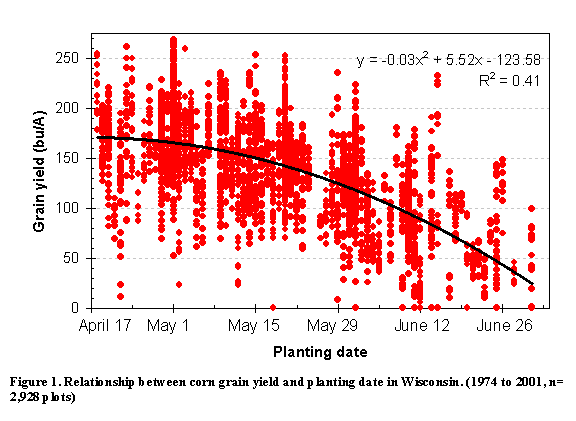Switching From "Full-" To "Shorter-Season" Corn Hybrids
May 14, 2003 10(9):73-74
Joe Lauer, Corn Agronomist
Due to the weather delays in corn planting, there is a growing concern about when
to switch from full- to shorter-season hybrids. Generally, May 20 is considered
the "magic" date to begin switching hybrid maturities in Wisconsin. In
general, the date to switch maturities becomes later as one moves south in the Corn
Belt.
The decision of when to switch hybrids maturities depends mostly on the intended
use of the crop. For dry grain the switch date is earlier than for high moisture
corn or silage. Increasing drying costs mean earlier switch dates.
In trials conducted at Lancaster, Arlington, Hancock, Marshfield, Spooner, and Ashland
both full- and shorter-season hybrids were planted. The shorter-season hybrid differed
from the full-season hybrid by 5 to 7 relative maturity units (days). Corn price
($2.00, 2.75, and 3.50 per bushel) and drying ($0.00, 0.015 and 0.03 per bushel),
hauling ($0.04 per bushel), and handling ($0.017 per bushel) costs were all factored
into the economic model used to determine switch dates between the full- and shorter-season
hybrids.

Corn grain yield was found to decrease about 0.3-0.5% per day during early May (Figure
1). The rate of grain yield decrease accelerated to 1.5-2.3% per day when corn was
planted later in May. Drying cost was the most important factor in determining switch
date between full - and shorter- season hybrids (Table 1). If corn drying costs
are relatively expensive (i.e. drying at a commercial elevator), then switch dates
were 7 to 11 days earlier than corn used as high moisture corn in a livestock system
or in years when there are no drying costs.
|
Table 1. Date to switch corn hybrids from full- to shorter- season relative maturity
in three corn production systems.
|
Corn production system
|
Drying cost
per bushel
|
Average for Marshfield,
Spooner, Ashland
|
Average for Lancaster,
Arlington, Hancock
|
|
Commercial elevator drying
|
$0.03
|
May 18
|
May 2
|
|
On-Farm drying
|
$0.015
|
May 23
|
May 6
|
|
Livestock (high moisture corn)
|
$0.00
|
May 25
|
May 13
|
Corn price had no influence on switch date in a livestock system. In an on-farm
drying system low corn prices required switch dates 1 to 3 days earlier at $2.00
corn compared to $3.50 corn. Corn price became increasingly important in the commercial
elevator drying system. Depending upon location, switch dates needed to occur 2
to 9 days earlier with $2.00 corn than with $3.50 corn.
Your decision to switch hybrid maturity depends upon:
1. Desire to accept risk: Full-season hybrids offer the highest yield potentials,
but may also increase drying costs and/or delay harvest.
2. Potential use of the corn produced
3. Field conditions: Although the penalty for late planting is important,
growers also need to be careful to avoid tillage when soil is too wet. Yields may
be reduced somewhat this year, but effects of soil compaction can reduce yields
for several years to come.
4. Hybrid dry-down and grain quality characteristics: Longer-season hybrids
within the latest acceptable planting dates should have fast grain dry-down and
high test weight characteristics. Growing season, site and management influence
a particular hybrid's actual days to maturity.
5. Ease of trading original hybrids for superior shorter-season alternatives.
Another aspect to consider when switching hybrid maturity is the risk associated
with the decision. In some years there are planting dates after May 20 that produce
grain yields as high as earlier planting dates (Figure 1). The growing season of
2003 could be one of those years, but the averages are that yields and economic
returns of full-season hybrids will be decreasing at a faster rate than shorter-season
hybrids. The difference full- and shorter-season hybrids can range up to about $50
per acre after May 20.